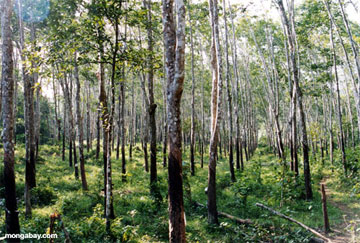Reforestation can be beneficial – or detrimental – it depends on the details
Reforestation can be beneficial – or detrimental – it depends on the details
Jeremy Hance, mongabay.com
June 12, 2008
Reforestation a growing, but complicated, initiative
As the rate of deforestation continues apace — 13 million hectares per year in a global basis — several countries have begun to look at reforesting degraded areas to aid suffering biodiversity, indigenous groups, and small local economies. However most of the interest and activity surrounding reforestation is as a tool to mitigate climate change. A new program just launched by the Nature Conservancy and several local partners plans to plant a billion trees in the fragmented Atlantic Forest of Brazil. The United Nations Environmental Program has already planted over two billion trees worldwide and plans to plant five billion more. China has planted billions more. However effective reforestation is not proving as easy as simply planting trees and waiting for them to grow, in fact, sometimes it may be best to leave the whole process to nature.
In a ‘perspective’ piece published in the journal Science, Dr. Robin Chazdon argues that the complexities involved in reforestation initiatives require a case-by-case analysis to determine whether natural regeneration or some form of human-guided reforestation is the best way to proceed. Considering the growing interest in reforestation, Chazdon believes it is best if done effectively, positing the question: “At what position along a forest degradation gradient does ‘accelerating succession’ through planting trees achieve faster recovery of forest structure and composition compared with unassisted regeneration? This question is challenging to address.” Challenging indeed: Brazil has attempted 98 forest reforestation projects with only two successes to speak of.

|
Using the metaphor of a staircase, with the the top being untouched forest, Chazdon says that depending on the state of the forest and its soil, some forest regeneration may benefit from human intervention, but that many secondary forests have proven that nature works better. Puerto Rico is an example: “After 30 to 40 years, natural regeneration following abandonment of pasture and coffee plantations produced secondary forests in Puerto Rico with biomass, stem density, and species richness similar to the island’s mature forests”.
Chazdon sees commercial plantations as the most problematic of reforestation initiatives–with the highest rate of failure. On her staircase, plantations are the lowest form of forest rehabilitation. In order to succeed Chazdon believes that plantations must be apart of “a heterogeneous landscape mosaic”.
Reforestation programs are growing every year. Tropical natural forests are expanding in countries like Cuba, Gambia, and Vietnam. Forests also continue to expand in Europe and the U.S. Much of the interest in reforestation is based on carbon storage and climate mitigation, but Chazdon cautions against quick solutions: “Fastgrowing, short-lived species with low-density wood are favored by many reforestation project designed to provide carbon offsets,” she writes, “but long-term carbon sequestration is promoted by growth of long-lived, slow-growing tree species with dense wood and slow turnover of woody tissues”.
Despite the positive and growing interest in reforestation, Chazdon is quick to state that new forests are not a solution to deforestation of existing forests: “Plantations and restored forests can improve ecosystem services and enhance biodiversity conservation, but will not match the composition and structure of the original forest cover”.
Chazdon says reforestation, like forests themselves, are complex. She believes the best method for regenerating new forests must take into account a wide variety of factors including financial support, soil quality, current vegetation, time frame, and the desired outcome. Chazdon estimates that a combination of reforestation and natural regeneration could allow forests to reclaim 700 million hectares in fifty years time.
Dr. Robin Chazdon is one the world’s leading experts on reforestation; she has been studying the regeneration of secondary forest for over twenty-five years.
Robin L. Chazdon (2008). Beyond Deforestation: Restoring Forests and Ecosystem Services on Degraded Lands. 13 JUNE 2008 VOL 320 SCIENCE














